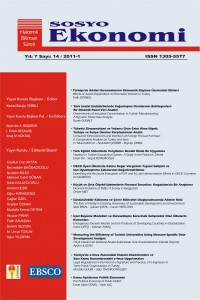Öz
This study measures the efficiency of Turkish universities through standard and measure-specific Data Envelopment Analysis (DEA) approaches. The purpose of this paper is three-fold. Firstly, the study shows the applicability of standard and measure-specific DEA methodologies in performance evaluation of Turkish universities. Secondly, it presents the benchmark shares which show the importance of each efficient university in measuring the inefficiencies of inefficient universities. Finally, the study analyzes efficiencies by means of the geographical regions which the universities are located.
Anahtar Kelimeler
Kaynakça
- Abbott, M. & C. Doucouliagos (2003). “The efficiency of Australian universities: a data envelopment analysis”, Economics of Education Review, 22(1), 89–97.
- Banker, R.D. & R.C. Morey (1986), “Efficiency analysis for exogenously fixed inputs and outputs”, Operations Research, 34, 513–521.
- Charnes A, W.W. Cooper, E. Rhodes (1978), “Measuring the efficiency of decision making units”, European Journal of Operational Research, 2, 429–444.
- Flegg, A.T. & D.O. Allen (2007), “Does expansion cause congestion? The case of the older British universities 1994–2004”, Education Economics, 15(1), 75−102.
- Johnes, J. (2006), “DEA and its application to the measurement of efficiency in higher education”, Economics of Education Review, 25(3), 273−288.
- Johnes, J. & L. Yu (2008), “Measuring the research performance of Chinese higher education institutions using data envelopment analysis”, China Economic Review, 19, 679–696.
- Seiford L.M. & J. Zhu (2003), “Context-dependent data envelopment analysis: measuring attractiveness and progress”, Omega, 31(5), 397–408.
- Thanassoulis, E. & R.G. Dyson (1992), “Estimating preferred target input-output levels using data envelopment analysis”, European Journal of Operational Research 56, 80–97.
- Ulucan, A. & Atıcı K.B. (2010), “Efficiency evaluations with context-dependent and measure-specific data envelopment approaches: An application in a world bank supported project”, Omega, Vol.38, 68–83.
- Worthington, A.C. & B.L. Lee (2008), “Efficiency, technology and productivity change in Australian universities 1998–2003”, Economics of Education Review, 27(3), 285−298.
- Zhu, J. (2000), “Multi-factor performance measure model with an application to Fortune 500 companies”, European Journal of Operational Research, 23 (1): 105–124.
- Zhu J. (2002), Quantitative models for performance evaluation and benchmarking—data envelopment analysis with spreadsheets and DEA Excel solver, Kluwer’s International Series.
Öz
This study measures the efficiency of Turkish universities through standard and measure-specific Data Envelopment Analysis (DEA) approaches. The purpose of this paper is three-fold. Firstly, the study shows the applicability of standard and measure-specific DEA methodologies in performance evaluation of Turkish universities. Secondly, it presents the benchmark shares which show the importance of each efficient university in measuring the inefficiencies of inefficient universities. Finally, the study analyzes efficiencies by means of the geographical regions which the universities are located.
Anahtar Kelimeler
Kaynakça
- Abbott, M. & C. Doucouliagos (2003). “The efficiency of Australian universities: a data envelopment analysis”, Economics of Education Review, 22(1), 89–97.
- Banker, R.D. & R.C. Morey (1986), “Efficiency analysis for exogenously fixed inputs and outputs”, Operations Research, 34, 513–521.
- Charnes A, W.W. Cooper, E. Rhodes (1978), “Measuring the efficiency of decision making units”, European Journal of Operational Research, 2, 429–444.
- Flegg, A.T. & D.O. Allen (2007), “Does expansion cause congestion? The case of the older British universities 1994–2004”, Education Economics, 15(1), 75−102.
- Johnes, J. (2006), “DEA and its application to the measurement of efficiency in higher education”, Economics of Education Review, 25(3), 273−288.
- Johnes, J. & L. Yu (2008), “Measuring the research performance of Chinese higher education institutions using data envelopment analysis”, China Economic Review, 19, 679–696.
- Seiford L.M. & J. Zhu (2003), “Context-dependent data envelopment analysis: measuring attractiveness and progress”, Omega, 31(5), 397–408.
- Thanassoulis, E. & R.G. Dyson (1992), “Estimating preferred target input-output levels using data envelopment analysis”, European Journal of Operational Research 56, 80–97.
- Ulucan, A. & Atıcı K.B. (2010), “Efficiency evaluations with context-dependent and measure-specific data envelopment approaches: An application in a world bank supported project”, Omega, Vol.38, 68–83.
- Worthington, A.C. & B.L. Lee (2008), “Efficiency, technology and productivity change in Australian universities 1998–2003”, Economics of Education Review, 27(3), 285−298.
- Zhu, J. (2000), “Multi-factor performance measure model with an application to Fortune 500 companies”, European Journal of Operational Research, 23 (1): 105–124.
- Zhu J. (2002), Quantitative models for performance evaluation and benchmarking—data envelopment analysis with spreadsheets and DEA Excel solver, Kluwer’s International Series.
Ayrıntılar
| Birincil Dil | İngilizce |
|---|---|
| Bölüm | Makaleler |
| Yazarlar | |
| Yayımlanma Tarihi | 1 Haziran 2011 |
| Gönderilme Tarihi | 12 Aralık 2014 |
| Yayımlandığı Sayı | Yıl 2011 Cilt: 14 Sayı: 14 |


